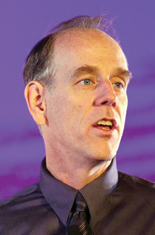Stephen Brobst
Chief Technology Officer, Teradata

Agile data warehousing architecture
This half day workshop examines the trends in analytic technologies, methodologies, and use cases. The implications of these developments for deployment of analytic capabilities using agile methodologies will be discussed with examples of future architecture directions and implementation. You will learn about:
- Interactive analytics using in-memory, columnar, and other emerging database technologies
- Analytics in the cloud
- Agile analytics deployment methodologies with integrated sandboxes
- Leveraging open source technologies such as Hadoop, R, PIG, Mahout, and other new generation opportunities
- NoSQL and NoETL analytic architectures
Izsák Tamás
Adatbázis szakértő és vezető fejlesztő, AppWorks
Bevezetés a MongoDB használatába
A félnapos workshop a vezető NoSQL adatbázis, a MongoDB tulajdonságait, architektúráját és alkalmazási területeit mutatja be. Foglalkozik az adatmodellezés, a lekérdezések és az adatmódosító műveletek, valamint a magas rendelkezésre állás és a skálázhatóság alapjaival.
A MongoDB a vezető NoSQL adatbázis, amely lehetővé teszi a vállalatok számára, hogy még agilisabbak legyenek és még hatékonyabban növekedjenek. A Fortune 500 vállalatai és a startup cégek egyaránt használják, hogy segítségével új típusú alkalmazásokat hozzanak létre, javítsák az ügyfél-élményt, lerövidítsék a piacra lépéshez szükséges időt és csökkentsék költségeiket.
A MongoDB egy agilis adatbázis, mely lehetővé teszi, hogy a sémák olyan gyorsan változzanak, ahogy az alkalmazások fejlődnek, miközben továbbra is biztosítja azt a funkcionalitást melyet a fejlesztők a hagyományos adatbázisoktól várnak, mint például a másodlagos indexek, a teljes lekérdezési nyelv és a szigorú konzisztencia.
A MongoDB legkiemelkedőbb előnyei a skálázhatóság, a teljesítmény és a magas rendelkezésre állás. Legyen az akár egyetlen szerveren vagy akár nagy, komplex, több-telephelyes architektúrán kiépítve. Kihasználva az In-Memory computing előnyeit, a MongoDB egyaránt nagy teljesítményt biztosít az olvasás és az írás területén. A natív replikáció és az automatikus feladatátvétel (failover) pedig biztosítja a vállalati szintű megbízhatóságot és működési rugalmasságot.
Tematika:
- Ismerkedés a MongoDB-vel
- Alapvető fogalmak
- Telepítés
- JSON / BSON
- MongoDB Shell
- Első adatbázis műveletek
- Alapvető fogalmak (documents, collections)
- CRUD (Create, Read, Update, Delete)
- Aggregation framework alapfogalmak
- Indexelés alapfogalmak
- Magas rendelkezésre állás (Replication)
- Koncepció
- Tervezés
- Terjeszkedjünk horizontálisan (Sharding)
- Koncepció
- Tervezés
Alex Dean
Co-founder, Snowplow Analytics Ltd
At Snowplow Alex is responsible for Snowplow’s technical architecture, stewarding the open source community and evaluating new technologies such as Amazon Kinesis. Prior to Snowplow, Alex was a partner at technology consultancy Keplar, where the idea for Snowplow was conceived. Before Keplar Alex was a Senior Engineering Manager at OpenX, the open source ad technology company.
Alex lives in London, UK.
From zero to Hadoop - running your first Hadoop jobs on Elastic MapReduce
This Workshop is an interactive tutorial to get attendees running their first MapReduce job on Hadoop (using Elastic MapReduce and Scalding).
Hadoop is everywhere these days, but it can seem like a complex, intimidating ecosystem to those who have yet to jump in. In this hands-on workshop, Alex Dean, co-founder of Snowplow Analytics, will take you "from zero to Hadoop", showing you how to run a variety of simple (but powerful) Hadoop jobs on Elastic MapReduce, Amazon's hosted Hadoop service. Alex will start with a no-nonsense overview of what Hadoop is, explaining its strengths and weaknesses and why it's such a powerful platform for data warehouse practitioners. Then Alex will help get you setup with EMR and Amazon S3, before leading you through a very simple job in Pig, a simple language for writing Hadoop jobs. After this we will move onto writing a more advanced job in Scalding, Twitter's Scala API for writing Hadoop jobs. For our final job, we will consolidate everything we have learnt by building a multi-step job flexing Pig, Scalding and Apache HBase, the Hadoop database. Agenda:
- Introducing Hadoop
- Our simple job:
- Setting up EMR, S3 and our local client tools
- Writing our Pig Latin script
- Running and inspecting our results
- Scalding:
- Introduction to Scalding and Cascading
- Writing our Scalding app
- Running and inspecting our results
- Putting it all together:
- Introduction to HBase
- Writing our second Pig Latin script
- Updating our Scalding app
- Running and inspecting our results
- Conclusions & next steps
Please bring
- Required: laptop
- Required: AWS account
- Nice to have: either Scala and SBT pre-installed on laptop, or Vagrant and Virtualbox
Gollnhofer Gábor
Adattárház üzletágigazgató, Jet-Sol
Hatékony ETL folyamatok kialakítása
A félnapos workshop az adattárház fejlesztési feladatainak legnagyobb részét kitévő adatintegrációs és ETL kérdésekkel foglalkozik, kitérve a legfontosabb tervezési, fejlesztési és üzemeltetési témakörökre.
A workshop során érintjük az ETL architektúrákat, a különböző ETL eszközöket, mappingek tervezését/kezelését, némi adatmodellezést, metaadat kezelést és DW automatizálást. Menetközben bemutatok egy-két használható eszközt, megoldást is.
A résztvevőket biztatom, hogy saját kérdéseket, problémákat is hozzanak, amiket a workshop során megpróbálunk közösen megvitatni és akár megoldani is.
MTA SZTAKI
Introduction to Stratosphere
Stratosphere Workshop and hackaton - Stratopshere basics
Agenda:
- Intro to Stratosphere and PACT 30 min
- Intro to Alternated Least Squares (ALS) and provision of a Java skeleton 30 min
- Coding different ALS implementations using the skeleton 90+ min
- Testing performance of the implementations against each other 30- min
- Bonus exercise: comparison with Mahouts Custom ALS implementation
MTA SZTAKI
Streaming principles with Stratosphere
Stratosphere Workshop and hackaton - Stratopshere Streaming
Agenda:
- Intro to Stratosphere Streaming 20 min
- Intro to ALS prediction 10 min
- Coding and testing ALS prediction 60 min
- Intro to ALS incremental and provision of a skeleton 30 min
- Coding and testing ALS incremental 60 min
- Bonus exercise: Implementing both ALS extension in the same streaming job